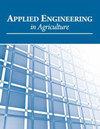Predicting Banana Yield at the Field Scale by Combining Sentinel-2 Time Series Data and Regression Models
IF 0.8
4区 农林科学
Q4 AGRICULTURAL ENGINEERING
引用次数: 1
Abstract
Highlights A dataset expansion method based on random sampling could improve the robustness of yield estimation models. CIRE was more suitable for banana yield estimation. XGBoost-based banana yield estimation method showed good prediction ability of banana yield. Abstract. Banana yield prediction at the field level offers significant benefits to growers, packinghouses, crop insurance companies, and researchers. This study explored a remote sensing-based approach for forecasting banana yield at the field scale by using Sentinel-2 (S2) image time series and regression models. First, S2 images of critical phenological periods for bananas were acquired from the Google Earth Engine platform, and these images were treated with cloud and cloud shadow removal. Second, the dataset was expanded by randomly selecting pixels for each field to improve the accuracy of yield prediction. Third, nine vegetation indices (VIs) with high correlation with crop yield were compared and analyzed. Chlorophyll Index Red Edge was selected with a particularly high predictive ability in banana yield prediction. Finally, six regression models, namely, least absolute shrinkage and selection operator (LASSO), support vector regression (SVR), k-nearest neighbors (k-NN), random forest (RF), gradient boosted regression trees (GBRT), and extreme gradient boost (XGBoost), were employed, and their performances were compared. Results showed that the best prediction of banana yield was when 70 pixels were selected for each banana field. Out of nine VIs, comparing different regression models, the XGBoost model emerged as the best learner (the average of R2 for 100 runs in 2019 and 2020 were 0.84 and 0.79, respectively). It was followed by the GBRT model with almost the same performance, which explained 82% and 79% of the banana yield variability for 2019 and 2020, respectively. The LASSO model exhibited the lowest performance of all, but it performed best in terms of stability. The proposed framework applied to satellite image time series can achieve reliable banana yield prediction across years at the field scale. Keywords: Banana yield prediction, Extreme gradient boost, Sentinel-2, Vegetation index.结合Sentinel-2时间序列数据和回归模型预测香蕉田间产量
基于随机抽样的数据集扩展方法可以提高产量估计模型的鲁棒性。CIRE更适合于估算香蕉产量。基于xgboost的香蕉产量估算方法具有良好的产量预测能力。摘要在田间水平上的香蕉产量预测为种植者、包装厂、作物保险公司和研究人员提供了巨大的利益。本研究利用Sentinel-2 (S2)遥感影像时间序列和回归模型,探索了基于遥感的香蕉田间产量预测方法。首先,从谷歌Earth Engine平台获取香蕉关键物候期的S2幅图像,对这些图像进行云和云影去除处理。其次,对数据集进行扩展,随机选取每个字段的像素点,提高产量预测的准确性;第三,对与作物产量相关性较高的9个植被指数进行了比较分析。叶绿素指数红边在香蕉产量预测中具有特别高的预测能力。最后,采用最小绝对收缩和选择算子(LASSO)、支持向量回归(SVR)、k近邻回归(k-NN)、随机森林(RF)、梯度增强回归树(GBRT)和极端梯度增强(XGBoost) 6种回归模型,并对其性能进行了比较。结果表明,每个香蕉田选取70个像素时,对香蕉产量的预测效果最好。在9个VIs中,比较不同的回归模型,XGBoost模型是最好的学习器(2019年和2020年100次运行的平均R2分别为0.84和0.79)。其次是GBRT模型,其表现几乎相同,分别解释了2019年和2020年香蕉产量变化的82%和79%。LASSO模型在所有模型中表现出最低的性能,但在稳定性方面表现最好。将该框架应用于卫星影像时间序列,可以实现可靠的大田尺度香蕉产量预测。关键词:香蕉产量预测,极端梯度提升,Sentinel-2,植被指数
本文章由计算机程序翻译,如有差异,请以英文原文为准。
求助全文
约1分钟内获得全文
求助全文
来源期刊

Applied Engineering in Agriculture
农林科学-农业工程
CiteScore
1.80
自引率
11.10%
发文量
69
审稿时长
6 months
期刊介绍:
This peer-reviewed journal publishes applications of engineering and technology research that address agricultural, food, and biological systems problems. Submissions must include results of practical experiences, tests, or trials presented in a manner and style that will allow easy adaptation by others; results of reviews or studies of installations or applications with substantially new or significant information not readily available in other refereed publications; or a description of successful methods of techniques of education, outreach, or technology transfer.
 求助内容:
求助内容: 应助结果提醒方式:
应助结果提醒方式:


